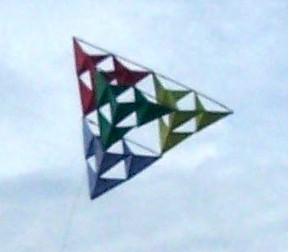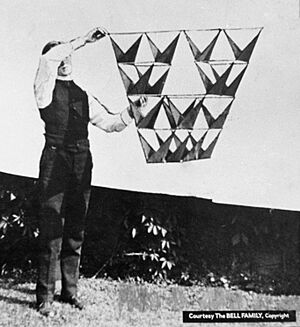Tetrahedral kite facts for kids
A tetrahedral kite is a special kind of box kite made from many small, pyramid-shaped cells. These cells are called tetrahedrons. They fit together to create a strong, lightweight structure, much like a space frame. Often, the whole kite itself looks like a giant tetrahedron.
Contents
Who Invented the Tetrahedral Kite?
This unique kite was invented by Alexander Graham Bell, the same person who invented the telephone! Bell started experimenting with kites around 1895. He was inspired by other box kites and wanted to build a kite that could be made very large. His big goal was to create a kite strong enough to carry a person and even a motor. This work was an important step towards manned flight.
Bell worked on these kites for many years, from 1895 to 1910. He even wrote about his discovery in the June 1903 issue of National Geographic magazine. The article was called "Tetrahedral Principle in Kite Structure."
Bell's Amazing Kite Experiments
Bell started with a simple kite that had just one tetrahedral cell. But he kept making them bigger and bigger! By 1907, he had built a massive kite called the "Cygnet." This huge kite had 3,393 cells!
The "Cygnet" was 40 feet (about 12.2 meters) long and weighed 200 pounds (about 91 kilograms). On December 6, 1907, a steamer boat towed this giant kite. It was flown offshore near Baddeck, Nova Scotia. Amazingly, the "Cygnet" successfully carried a man 168 feet (about 51.2 meters) above the water!
Bell also tried out other designs during this time. He even experimented with a large, round structure made from tetrahedral shapes.
Flying a Tetrahedral Kite
Tetrahedral kites are known for being very stable in the air. This makes them easy to fly once they are launched. However, they are not the best kites for light winds.
Because they have so many parts and spars (the long, thin pieces that make up the frame), these kites can be quite heavy. This means they need moderate to strong winds to get off the ground and stay flying.
See also
 In Spanish: Cometa tetraédrica para niños
In Spanish: Cometa tetraédrica para niños



